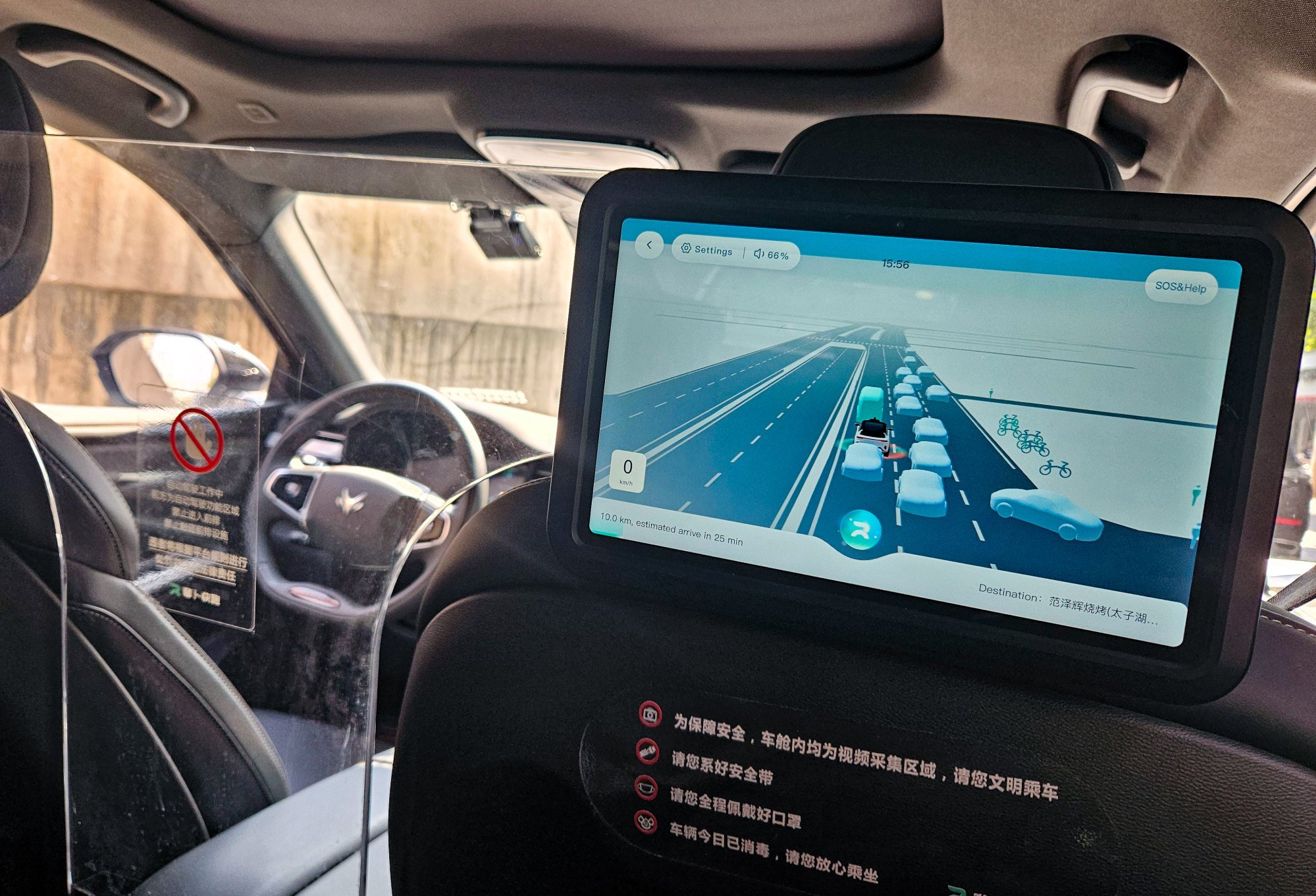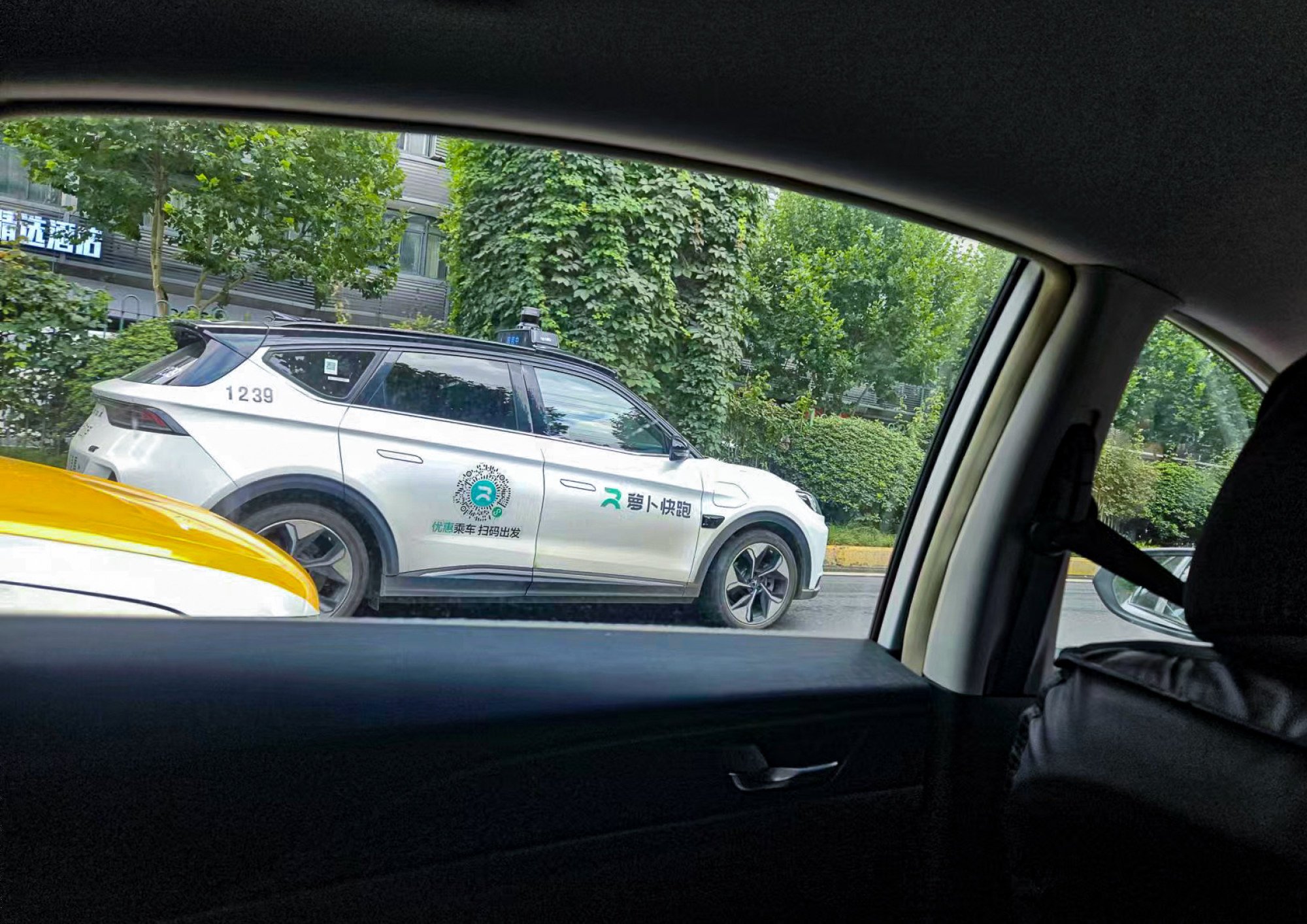In Wuhan, driverless taxis offer a peek into the future of intracity transport
Operating under the brand name Apollo Go, the largest Wuhan fleet is owned by Chinese search engine giant Baidu, which has invested heavily in autonomous vehicles in recent years. Other companies like Dongfeng Motor Corp and DeepBlue Technology have also been testing their autonomous taxis and shuttles in the city.
College student Andy Zhou tried an Apollo Go ride twice in two days, noting that young people in the city were keen to try the service. “When I was on board, I got a lot of attention from surrounding drivers. Some even took photos,” he said.
Zhou said he felt safe in the robotaxi, which can reach speeds of up to 60km per hour in the downtown area. The only difference was that driverless cars hit the brakes more often than human drivers would, particularly when traffic lights changed or other drivers cut into the lane. In one instance of sudden braking, Zhou said he spilled an open bottle of Coca-Cola.
In Wuhan, known for its hot, humid summers, the white robotaxis are easily recognisable on the road, as their rooftops are fitted with a cylinder-shaped sensor. They have a rooftop information display that indicates “in service”, “turning left/right” or “making a U-turn”. While many of the cars do not have a driver behind the wheel, some require a human safety driver, depending on the type of licence issued to the operator.

In comparison, the regular taxi fleet in Wuhan are cars made by the Dongfeng Peugeot-Citroën joint venture, recognisable by their white/blue or white/yellow paint job.
While the Apollo Go vehicles do not respond to old-fashioned hailing on the roadside – still the most common way to get a taxi in Wuhan – ordering a driverless ride is easily done via the Apollo Go or Baidu Maps apps, or the Apollo Go mini-programme embedded in Tencent Holdings’ super app WeChat.
The robotaxis avoid certain overcrowded tourist attractions, such as the city’s famous Yellow Crane Tower and the Wuhan University campus, but the coverage is wide enough to include places like Hanzheng Street, Wuhan’s biggest wholesale market. They also take reservations for pick-ups and drop-offs at the Wuhan Tianhe International Airport.
When the car arrives, the user unlocks the door by inputting the last four digits of their registered Chinese phone number, using a touch screen embedded in the vehicle’s rear window. Once seated, the passenger can start the car by touching a “Start Ride” button on a pair of tablet displays mounted on the back of the front seats. The infotainment system on the tablets offers real-time trip information in Chinese and English, and allows passengers to adjust the air conditioning, access Netease’s music streaming service, or watch promotional videos about Baidu and its self-driving technology.
Each car can carry up to three passengers, and all must be seated in the back. Pregnant women, infants and those older than 70 years are not allowed to use the service, while pets and large items of luggage are also not allowed.
The robotaxis are seeing a surge in popularity thanks to their competitive pricing. A ride the Post took from the Third People’s Hospital of Hubei to the Qintai Grand Theatre, a distance of three kilometres, cost only 4.2 yuan (US$0.60) after a heavy discount from the nominal fare of 24 yuan. In comparison, the same trip in a regular taxi costs 15 yuan.
The easy-to-use service and subsidised fares have quickly made Apollo Go cars much sought-after in Wuhan. Even during non-rush hours, the waiting time for a ride can be up to half an hour. College student Zhou said he had to wait over an hour for his robotaxi after he ordered on his phone. Wang Lei, a 24-year-old salesman who has taken multiple Apollo Go rides, said he would only choose the service if he was not in a hurry. “I may prefer an Apollo Go car when travelling to the suburbs, because it’s cheaper and the traffic is not so busy,” he said.

Not surprisingly, the popularity of the robotaxis in Wuhan has upset some of the city’s taxi operators.
An open letter published late last month by the Wuhan Jianshe Automotive Passenger Transportation, a local operator, said four of its 159 taxis drivers have quit since April due to declining income, according to a report by the Southern Weekly newspaper. The company accused robotaxis of “taking jobs from the grass roots”.
The issue is also hotly debated among the national population. An ongoing survey by Chinese media The Paper, which has so far polled 3,000 respondents, found that 51 per cent thought robotaxis would replace human drivers, while 35 per cent thought they would have some impact but not replace regular taxis entirely. Only 12 per cent believe there will be no impact.
The deployment of autonomous cars in cities like Wuhan has amplified job security fears, as driving a ride-hailing car and delivering online food orders are regarded as the wages of last resort for able-bodied people amid China’s economic slowdown. In a country where unemployment benefits are not available for most people, taxi driving offers a low-threshold job with steady cash flow. According to the latest figures from China’s transport ministry, there were 7 million licensed taxi-hailing drivers across the country as of the end of May.
While the scale of the experiment in Wuhan is small, Baidu aims to break even in the city by the year-end, and has indicated that the service could be rolled out across the country after that. Chen Zhuo, general manager of Baidu’s self-driving unit, said in May that the company plans to “replicate the successful experience of Wuhan” in other cities.
JPMorgan Chase analysts Alex Yao and Daniel Chen wrote in a research note that Baidu could see “single city” break even in the second half of 2024, with changes in the current pricing strategy, vehicle costs and safety monitor ratio. For now, some Apollo Go robotaxis are only licensed to operate in Wuhan with a safety operator behind the wheel, and driverless vehicles are monitored remotely at a minimum ratio of one operator for three vehicles.

“Baidu’s single-city margin is likely to increase substantially in the second half of 2024 as the three key variables move in a favourable direction,” the analysts wrote.
Other Chinese cities have shown enthusiasm for embracing driverless technology. Beijing, Shanghai and Shenzhen have allowed robotaxis on designated roads or in certain areas, but generally not downtown. Shanghai will also put robotaxis on some roads in the Pudong financial district as early as next week, with licenses granted to four robotaxi companies – Baidu, AutoX, Pony.ai and SAIC AI Lab.
Beijing has given the greenlight to Baidu, Pony.ai, WeRide and AutoX to operate automated shuttle services between Beijing Daxing International Airport and the hi-tech Yizhuang area, although the services still require a safety driver behind the wheel.
However, the commercial roll-out of robotaxis is still in its infancy, as it requires “higher perception and decision-making planning ability”, according to Hong Wanting, a senior analyst at market research firm IDC in China. “Robotaxis are still restricted to certain areas, or require a number of remote control personnel to do security redundancy and backup programs,” Hong said.
Baidu is China’s leading firm in the self-driving industry, having reached level-4 category, in which vehicles are capable of fully autonomous operation without human intervention. So far, the technology has a near perfect safety record in China, with the most serious traffic accident involving a robotaxi only resulting in a scratch on a vehicle.
Back in Wuhan, a driver surnamed Lin, who works for the Geely-owned Caocao Mobility ride-hailing platform, said robotaxis have good “road manners” because they never speed or cut off other drivers, but that behaviour slows down traffic.
None of the six taxi drivers that spoke to the Post said they were concerned about job losses given the limited driving skills of robotaxis compared with humans.
A driver surnamed Zheng, who works for one from the Didi Chuxing platforms in Wuhan, said he would move out of the city if Apollo Go began to take away too much business.
A driver surnamed Lu, in his early 50s, endorsed the technology given China’s ageing population. “I’ll retire in a decade. [I have] no fear [of losing work], but there will be fewer people [as drivers]. We will need [driverless cars] in future.”

